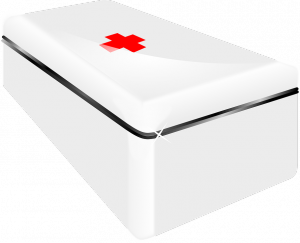
 Although mountain biking is a lot of fun, it can also get tricky at times. That is why I decided to post these mountain biking tips techniques, and rules that any mountain biker will find useful.
Although mountain biking is a lot of fun, it can also get tricky at times. That is why I decided to post these mountain biking tips techniques, and rules that any mountain biker will find useful.
Now and then when you are cycling, you will come across various obstacles that you will need to get over or around of, with as little damage to yourself and your bicycle as possible. These common obstacles are normally put around parts of any mountain biking trail purposefully.
Mountain Biking Tips Techniques, and Advice
Here are some of the more common mountain biking tips and techniques for various obstacles:
Objects in the Road:
One of the more common obstacles is to have a fallen tree or log come up in front of you. You can try and ride over it instead of around it. Just look for the smallest and flattest part of the log to cross. On the most used mountain biking trails, logs will actually have a cutout, especially for bikers. You simply aim your front tire directly at the opening.
Other things that you could come across on trails that are specially built for mountain biking are rock piles, jumps, and other added obstacles. These elements add a challenge to your ride but most of the manmade features will offer an alternative route around. First time around, rather take the alternative route so that you can access the obstacle and the landing area before attempting and possibly injuring yourself.
Going Down Steep Hills:
If you need to go down a steep incline, make sure you survey the situation by getting off your mountain bike. In fact, you should survey any unfamiliar trail feature off of your bicycle. Once you feel confident to ride again, look well ahead of you and identify obstacles and steep parts before you actually get there. If the trail is a popular one for mountain bikers, you will most likely be able to distinguish a path that is the most commonly traveled route through that particular section of the trail.
What Are the Mountian Biking Rules and Regulations?
Here are some mountain biking rules that I picked up from the International Mountain Biking Association. These rules are designed to minimize our impact on the environment, as well as promote friendly relationships with other trail users. Rules help to create a safe environment for all and all mountain bikers should try and live by these rules from the International Mountain Biking Association. These rules often serve as mountain biking tips techniques, and tricks as well.
The manner in which we ride our mountain bikes today will shape mountain bike trail access tomorrow, so do your part to preserve the sport’s access and image by trying your best to follow all the rules, as they are recognized worldwide as the standard code of conduct for all mountain bikers.
Mountain Biker Rule Number 1:
Make sure to follow the trail and avoid trespassing on private land. If necessary, obtain your permits or other authorization as required beforehand. Most federal and state wilderness areas are not open to cycling, so if unsure, ask first.
Mountain Biker Rule Number 2:
Try to practice low-impact cycling. In other words be sensitive to the dirt beneath you. Learn to recognize different soil types and the construction of the trail. The more wet the trail, the more prone it is to damage. Stick to the trails by not creating new trails and don’t cut switchbacks.
Mountain Biker Rule Number 3:
Learn to control your bicycle and obey all the speed regulations. This will help you to stay safe, especially if you can’t see what is coming up ahead, as you need time to react.
Mountain Biker Rule Number 4:
Let other mountain bikers know that you are coming with a friendly greeting with your bell. Show respect when passing other riders by slowing to a walking pace or stopping if necessary. Watch out especially around corners and in blind spots.
Mountain Biker Rule Number 5:
Avoid startling the wildlife, as animals are easily startled and it could be dangerous for you, others and the animals themselves. Use special care when riding past horses and follow any directions from horse riders. Make sure to leave all gates as you found them, whether open or closed or as marked.
Mountain Biker Rule Number 6:
Learn to know your equipment, your ability and adjust it to the area that you are riding in. Be self-sufficient at all times and keep your equipment in good repair. Prepare for weather changes and make sure to always have the right equipment so as not to burden others.
If all mountain bikers follow the above rules, trails will stay open because cyclists will be setting a good example of environmentally sound and socially responsible off-road cycling. There will also be far less risk of bad accidents and damage to your bicycle.
What If Your Cycling Buddy Is In An Accident While Out Mountain Biking?
 Unfortunately, accidents do happen, even when following mountain biking tips techniques and rules. Broken bones and fractures are a common phenomenon when doing mountain biking in the great outdoors. Here is what to do if your cycling buddy breaks something while out riding with him, for instance a broken bone.
Unfortunately, accidents do happen, even when following mountain biking tips techniques and rules. Broken bones and fractures are a common phenomenon when doing mountain biking in the great outdoors. Here is what to do if your cycling buddy breaks something while out riding with him, for instance a broken bone.
Always think ABC (Airway, Breathing, and Circulation).
Get your victim to a safe, warm and dry place and arrange the injured area so that the pain is least felt. The body will initiate a defense response after a bone is broken by making the area around the injury swell up, in an attempt to protect the area. This will be the main clue that the bone is either broken or fractured.
A broken bone may also sometimes become displaced. This means that the fragments of bone are no longer in the normal alignment. This could cause the broken fragment to kink, block or even cut the blood vessels within the limb. If there is no blood flow to the limb, the person may lose that extremity, even after only a short period of time.
If for instance, your friend breaks his or her leg, you need to check the foot pulse. Compare by feeling the other leg, and if you can’t feel a pulse, then it could be one of the following:
- You could be feeling in the wrong place.
- If the person is in shock, the peripheral arteries will be clamped and hard to feel.
- If the person is cold, you will also battle to find a pulse as the arteries will be clamped.
If the extremity is blue and cold, you may need to distract or pull apart the broken ends and then splint the extremity in such a way that the artery will not become recompressed during transport to the hospital. This process will hurt like hell and should be done as quickly and efficiently as possible.
If anyone has painkillers or muscle relaxants, make sure to administer them as soon as possible as they normally take about twenty minutes to kick in. Remember to check that your patient is not allergic to anything.
Before attempting to splint, make sure you know how to do this properly, as you could cause much pain if you are not quick and efficient. A basic first aid course will have needed to be done in this case.
If the clavicle is broken, the bone cannot be splinted. Rather just fold the arm at a ninety-degree angle across the chest and strap down with bandages, not too tightly.
It is always advisable to get some sort of First Aid Training before embarking on any extreme sports, as you never know when your training will come in handy.
Please feel free to add in more mountain biking tips, techniques and any other related information you may want to add.
